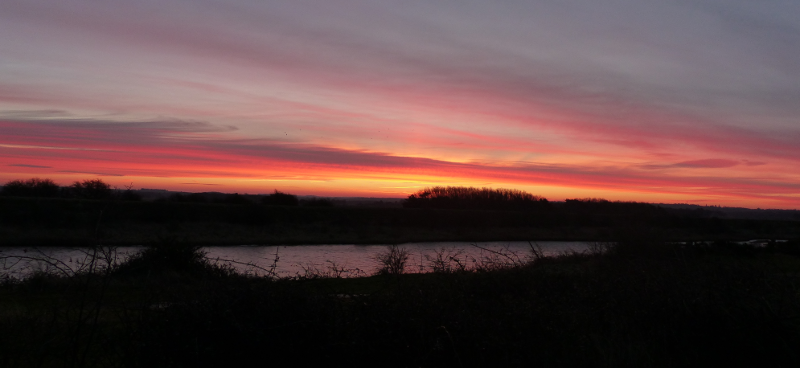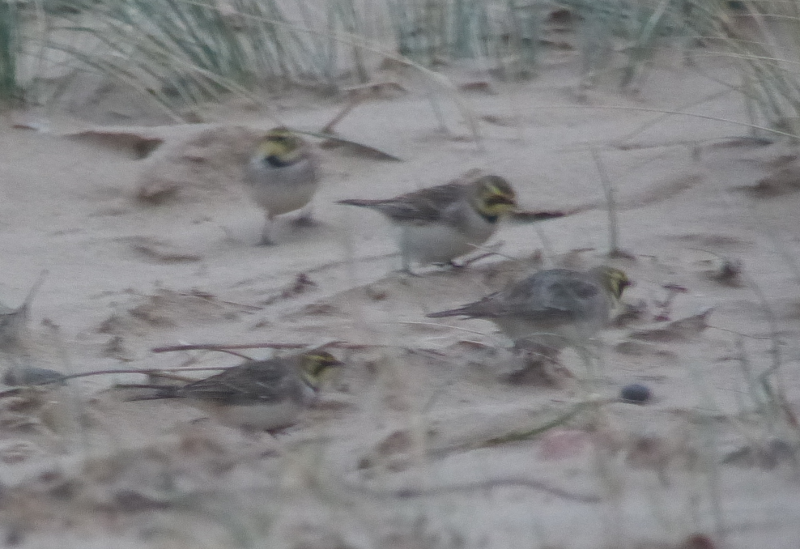Average Birding

North Norfolk Surprise
The next weekend stays mysteriously free. A short-notice winter trip to Norfolk is hastily planned; we'll do our usual trip of picking up a car from Stansted Airport and driving the rest of the way.
This entry covers the Saturday of that weekend (27th January 2018); enough happened to merit separate entries for each day.
Pronoun guidance: as ever, AB1 is the designated driver.
An inauspicious hostelry
After a gnarly drive from Stansted to King's Lynn in the dark (what is going on with A10 at Littleport?), we bed down in a room above the local Wetherspoons. The Brexit pamphlets are not nearly as amusing as being woken up at three in the morning by...is that someone coughing? Or maybe choking? Oh, no, that would be vomiting. Delightful.
A Snettisham Spectacular?
We're up not too long afterwards. A busy day awaits us and we need to be at Snettisham a good half hour or so before first light if we're going to catch up with the Pink-footed Geese coming in off the Wash.
AB2 is not at all convinced by this plan, but having bundled her into the car, her mood improves (as a side note, I suspect the soothing effect on AB2 of being chauffeured around is no small part of our relationship's stability). We find the correct car park (one step better than I managed the last time I was here), kit up and traipse off along the trail towards the Wash. There's just enough light to not need a torch.
I'm vacillating between excited and fearful - the RSPB's website maintains a list of the dates it is sensible to see this spectacle, and while yesterday was listed, today is not. I'm hoping there's enough noise in that schedule that we're going to be lucky; I'm going to be in trouble for this early start otherwise.
It's a pleasant enough walk to the beach and we pick up the first Little Grebe of the year on the way. Otherwise, there isn't much about.

We reach the beach and continue South towards the hides - a few waders that are new for the year (Oystercatcher, Knot) provide some distractions, but they aren't what we're really here for. Having adjudged that we've come far enough, I cup my ears towards the water. Not a lot. Staring at the horizon doesn't help much either - there doesn't seem to be anything happening.
Oh dear.
A few minutes pass; I do my very best impression of someone who remains convinced that something is going to happen. Thankfully, the pretence isn't required for long; the excited honks and squeaks of a few thousand geese start to reach the beach. It isn't much longer before the first skeins (such a delight to deploy that word) start passing overhead.
This is the really good bit. There's something about the noise of the geese; it's a party atmosphere; they're off for a banquet of beets just inland, and every goose is invited. They all sound pretty excited about it, and the feeling is quite contagious; I suddenly realise I'm grinning like an idiot.
This lasts a good old while - there are thousands of these geese on their way to breakfast, and it takes a good half an hour for them all to get over us. I note with relief that AB2 is similarly cheered.
We do a quick loop around pit four, taking in all the hides. I roundly misidentify some Greylag Geese as Pink-footed for a short while in the first of them (not enough sleep), but the rest of this trundle is more productive. A Marsh Harrier is quartering over a reedbed to the South. A Skylark comes to have a look at us. Two Red-legged Partridge fly off in a panic when we get too near. Both partridges before the end of January - not bad! We return to the car by around half past eight and set out to find ourselves a well-deserved breakfast at the The Old Bank Bistro.
Who are these people?
Refuelled, we set out for Titchwell. It takes a gloriously small amount of time; I'd forgotten how close together everything is in North Norfolk. We park up, use the facilities and start to head into the reserve, when a car entering the car park unceremoniously beeps at us. We've not had much sleep, so this immediately raises our heckles: Who dares beep at us when we're not even in the way? Oh, it's Mum and Chris. What are they doing here?
Well, obviously, the same as us. Mum had mentioned a trip to Norfolk was happening, but as far as I knew, the scheduled window for it had ended a couple of days ago. Evidently plans had changed, or (more likely) I wasn't paying attention. Four pairs of eyes being better than two, we join forces; surely nothing can stop such a birding team!
Apart from the weather. Which, as we progress further towards the beach, slowly deteriorates from harmless grey to the light but penetrating drizzle that doesn't feel that dangerous but will handily soak you through in under five minutes of exposure.
We're restricted to some very brisk walks between extended stays in the hides. Mum and Chris share details of their exploits over the last couple of days; useful for our own planning.
The visit ends up being short, but productive. From a year perspective, the best find is probably Bar-tailed Godwit. It's important because a) one doesn't see them often and b) discerning the difference between Bar and Black-tailed is difficult.

A bit of scope deployment on the beach yields Common Scoter and Red-breasted Merganser, (no Long-tailed Duck, though). A drake Red-headed Pochard shows off on the freshwater marsh - not that exciting, but good to have found it at this stage.
We part ways from Mum and Chris (who are off to see if they can find Twite at Thornham) and continue our journey East. Our next stop is Holkham; at this time of year there are reliable Shore Larks amongst the dunes. In addition, there are reports of Bewick's and Great Egret elsewhere in the area.
Hangry of Holkham
This is not the best timed visit. The weather is crappy. It's borderline lunchtime. I deny any possibility that I might be hungry and we march off towards the beach. We get to the beach. The beach is big. Which way should we go? The instructions are clear, we should go East. But how far? What are 'saltings'?
We guess that the long lumpy barrier parallel to the sea and forming the boundary between the beach and a marshy area is where we should look. This yields some very confiding Sanderlings and Turnstones, but no Shore Larks. A band of more serious rain turns up and we head back inland to take cover in the woods, wondering if the whole Shore Lark thing is a con. Perhaps it is someone's idea of a sure lark, ho ho. A few Goldcrest entertain us while we decide what to do.

Once the rain backs off a little, we have a bit more of an explore. The results, though, are similarly irksome. We poll a large group of birders on our way back about their luck, and they've seen the Shore Larks, and the Great Egret.
We head to the hide where the egret was seen, and, as we open the door, something that looks the right shape and size is flying off to the extreme right of what is visible. It drops down behind some reeds as I sit down. Hmm. Not good enough for the list - I'm sleep deprived and hungry, I could very well be making it up at this point. Of non-Mute Swan species, there is also no sign. Still, at least the hide has got us out of the rain.
We trudge back to the car once the rain eases off further to lick our wounds, and, more importantly, go in search of food. A fish and chip shop in Wells-next-to-the-Sea is chosen and we hoof down the oversized portions with gusto.
That's better. With blood sugar returning to sensible levels, the never-say-die ultra-birder in my head has re-examined the OS map and decided it might be worth having another bash at Shore Lark from the Wells end of the beach.
On my side is the pleasing aspect of the Wells end, and an improvement in the weather. A murky trek in a freezing gale this is no longer; now it's a pleasant stroll in the sun along a most attractive bit of sand, with cute little beach huts perched at the border of the beach and the woods behind.
We quickly reach the eastern end of the lump we were following from the other end and agree: we're going to walk along here for fifteen minutes, tops. Only a couple of minutes pass before my keen scanning of the next 100m or so picks up a flock of eight birds that aren't the right shape to be either the Sanderlings or the Dunlins from earlier. They sit down on the beach side of the long lump (salting?) and disappear.
Keen not to frighten them off, we move towards the sea from the salting before moving in their direction. This works quite nicely, and the birds graciously decide that they're going to scuttle towards us. As they get closer it's obvious they are the Shore Larks - the head is unmistakable.
We stay still in the hope of getting a photo or two, but a combination of their scuttling speed and the dreadful light conditions (on reflection, I perhaps exaggerated how improved it was in a haze of fish and chips) make it a bit tricky. Still, great success! They do exist after all.

Exit, Stage Right
At this point, it feels like we ought to be done for the day. Even with the early start, the light is starting to fade. We've got a reservation just beyond Cromer and we should start to make our way there. I console myself that, in the darkness, the various reports I am driving past aren't really things I am missing out on. It's been an excellent day, in any case, the Pink-footed Goose party and the Shore Lark search in particular.
An enthusiastic host greets us at our B&B in Cromer. We are once again starving and it turns out I've planned the birding parts of this trip brilliantly, but the logistical parts less well. A nearby corner shop is visited, two pot noodles are acquired and then clandestinely consumed in our room. Tomorrow is another day.